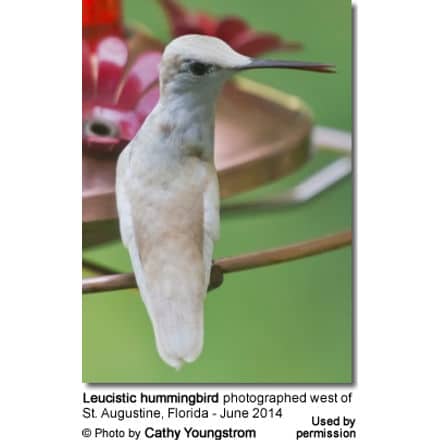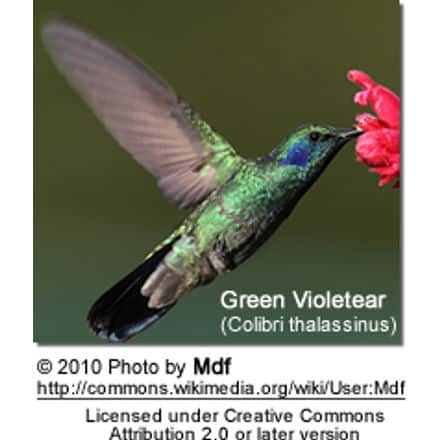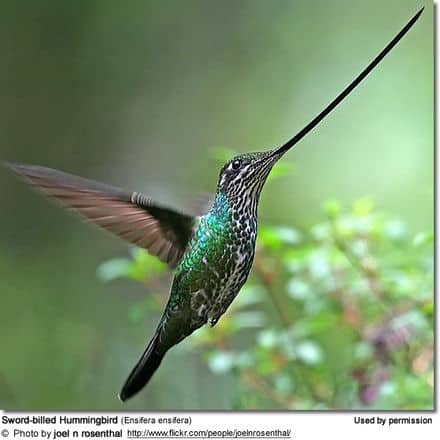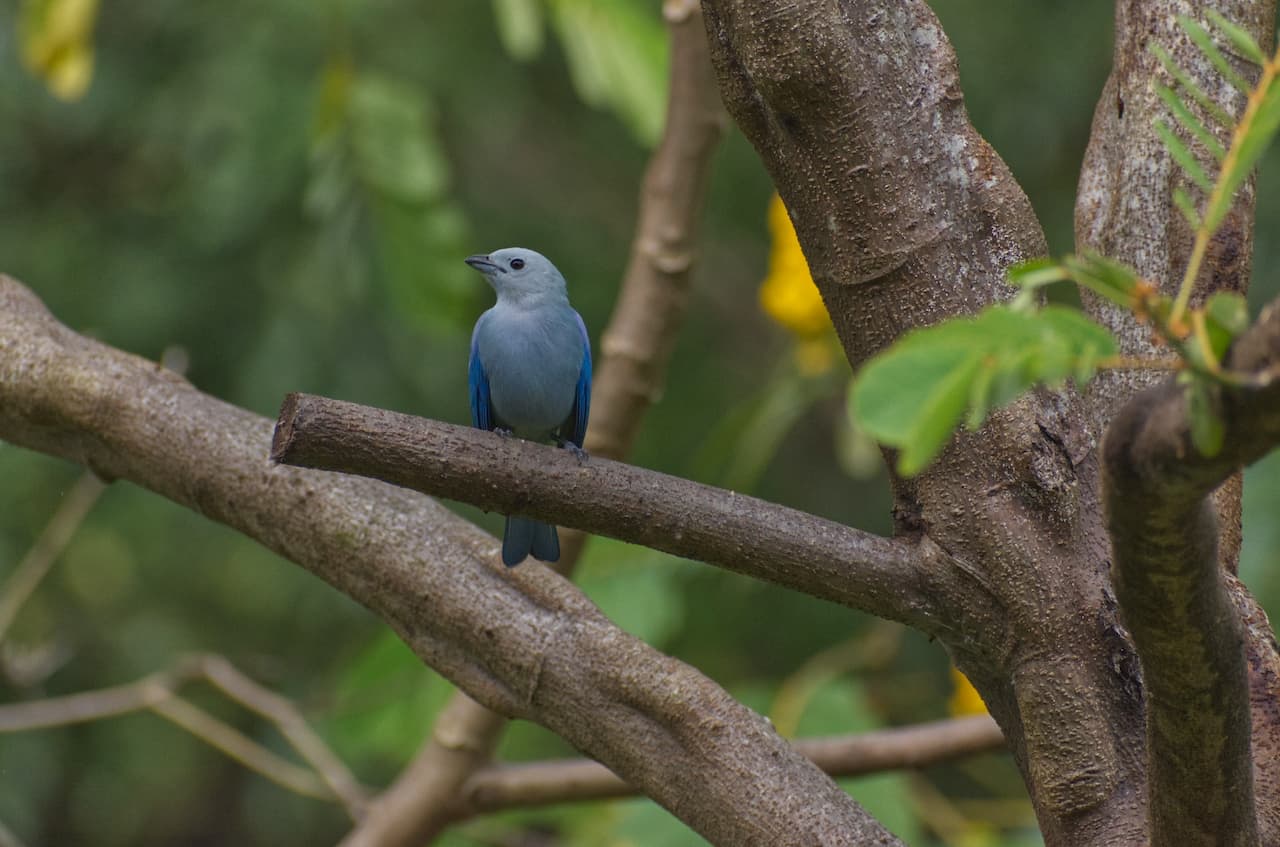Hummingbirds found in Florida
Hummingbirds found in the USA (by U.S. State) … Canada … Mexico … Puerto Rico … Jamaica … Honduras
Hummingbirds found in Florida
Hummingbird Information … Hummingbird Species Photo Gallery
Following listed (with photos) are hummingbirds found, or potentially found, in Florida.
Ruby-throated Hummingbirds (Archilochus colubris) – Native and most common hummingbirds in Florida between early to mid-March and usually leave by the end of October. Migrating males are usually the first to arrive and the first to depart. The females and the young usually follow about two weeks later.
The male has a ruby-red throat, a white collar, an emerald green back and a forked tail.
The female has a green back and tail feathers that are banded white, black and grey-green.
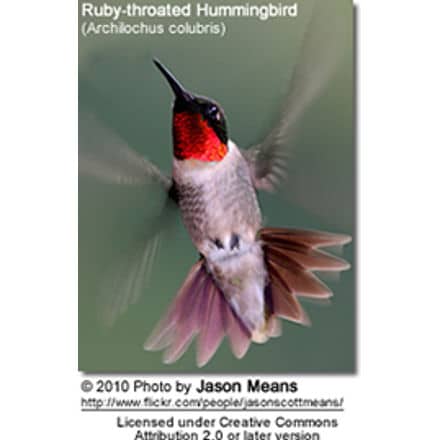
September 2016: Linda Young photographed a white hummingbird in Freeport, FL that appeared at her feeder on 9-25-2016 and on following days. [Photo submitted for verification – unpublished]
June 2014: Cathy Youngstrom photographed the below leucistic hummingbird about 18 miles west of St. Augustine, northern Florida. She reports that this beautiful hummer has been feeding at her location for about 10 days and feeds together with about 8 resident Ruby-throated Hummingbirds. One can assume that this partial-white hummingbird is also a Ruby-throated.
Rufous Hummingbirds (Selasphorus rufus) – Natives
These hummingbirds are usually found in gardens and at feeders. These birds are fearless, and are known for chasing away other hummingbirds and even larger birds, or rodents away from their favorite nectar feeders and flowers.
Males can easily be identified by their glossy orange-red throats.
Females have whitish, speckled throats, green backs and crowns, and rufous, white-tipped tail feathers.
Rufous Hummingbird versus the similar Ruby-throated Hummingbird (Identification)
Calliope Hummingbirds (Stellula calliope) – Natives
The smallest breeding bird in North America. They are most easily confused with the Rufous Hummingbirds and the Broad-tailed Hummingbird.
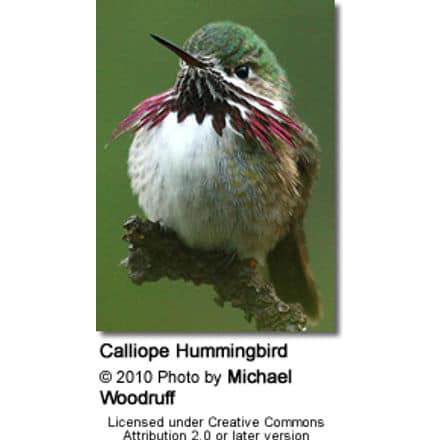
Black-chinned Hummingbirds (Archilochus alexandri) – Natives
The male has a black, shimmering throat with a purple edge and pale feathers below that create a collar. However, unless the light is just right, the head looks all black. His back is green and there are some green feathers covering the chest.
The female is pale below (sometimes with a slightly speckled throat) and her back is green.
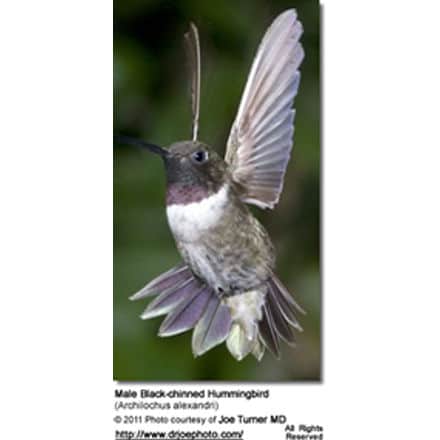
(Amazilia yucatanensis) – Natives (found mainly in the panhandle)
The male’s throat is a metallic golden green and the red, dark-tipped bill is straight and slender. Back and head are mostly metallic olive. The lower chest ranges in coloration to whitish with various shades of grey or green, or buffy (yellowish-brown).
The tail and primary wing feathers are rufous (reddish-brown) and slightly forked. The underwing is white.
The female is generally less colorful than the male and has a a dark upper bill
Broad-tailed Hummingbirds (Selasphorus platycercus) – Natives
Males can most easily be identified by their iridescent, rose-red throats, white chest feathers and metallic green back and crown and their rounded tails. The males’ tails make whistling noises in flight.
Females lack the flashy throat patch of the male and are mostly pale below. Their white-tipped outer tail feathers are rust-colored close to the body and blackish in the center; the tail feathers in the center range from green to blackish.
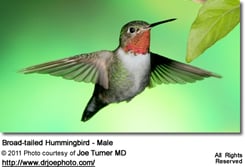
Allen’s Hummingbirds (Selasphorus sasin) – Rare vagrants – The Allen’s Hummingbird is often confused with the Rufous Hummingbird, but the Allen’s can be identified by the green back whereas the Rufous Hummingbird has a coppery back.
The male has a throat that ranges in color from orange-red to yellow-orange, a back that is bright green, a rump that is rufous and its tail feathers are rufous tipped in black.
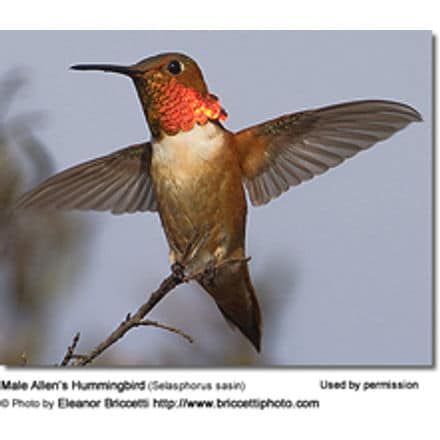
Anna’s Hummingbirds (Calypte anna) – Accidental / Vagrants
One of the larger and the most vocal hummingbirds in the United States, where it is the only species to produce a song; specifically the males produce a complex series of scratchy noises, sounding like a sharp “chee-chee-chee; when moving from flower to flower, they emit toneless “chip” vocalizations. All other hummingbirds in the United States are mostly silent.
They are well known for their territorial behavior; the male makes elaborate dive displays at other birds and sometimes even at people. At the bottom of their dives, they produce high-pitched loud popping sounds with their tail feathers.
Males have glossy dark rose-red throats and crowns, which may appear black or dark purple in low light. The underside is mostly greyish; and the back metallic green.
Females have light grey chests with white and red spotting on the throat, greenish back and white tipped tails.
They resemble the Costa’s Hummingbirds, but the male’s Costa’s Hummingbird’s gorget (throat feathers) is longer than that of the Anna’s. They are larger than the Rufous Hummingbirds and lack the rusty coloration of the Rufous Hummingbirds.
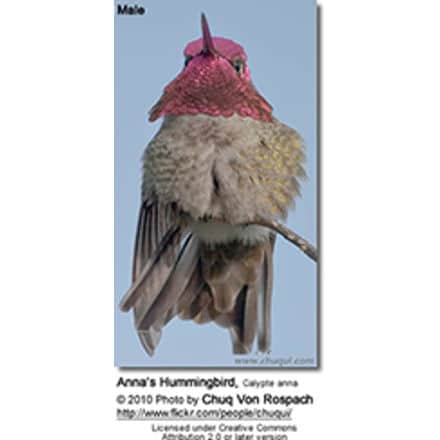
Bahama Woodstars (Calliphlox evelynae) – Rare vagrants
Their range is mostly restricted to the Bahamas; however, some vagrants made it to Florida.
Their plumage is green above with mixed olive-buff underparts. The male has a reddish-pink throat lined by a white collar during breeding season. After breeding season is over, he loses the colorful throat, which then turns a pale grey color (known as “eclipse plumage”).
The female has a much duller plumage. She has a rounded tail – while the male’s tail is deeply forked.
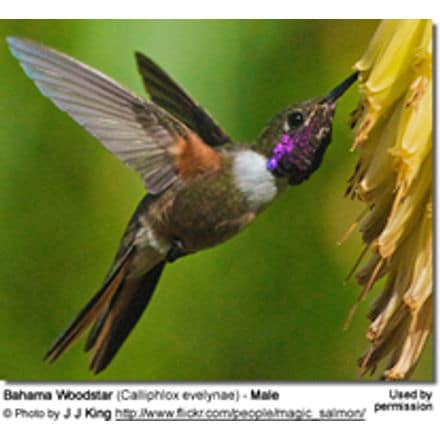
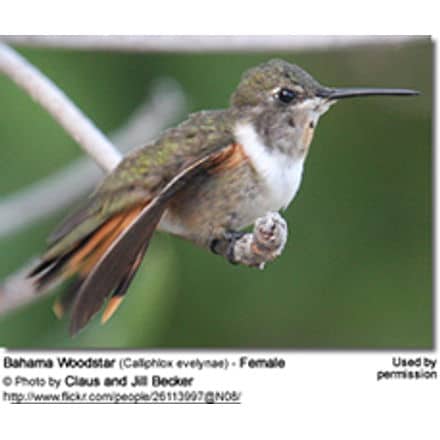
Broad-billed Hummingbirds (Cynanthus latirostris) – Accidental / Vagrants– These mostly Mexican hummingbirds venture into the United States regularly; they mostly visit the southern parts – but a few vagrants travel as far north as Wisconsin.
The male is glossy green above and on the chest. He has a deep blue throat. His straight and slender beak is red with a black tip. His slightly forked tail is dark above, and the under tail feathers are white.
The female is less colorful than the male. Her throat, chest and belly are light to medium grey. She has a white stripe over each eye.
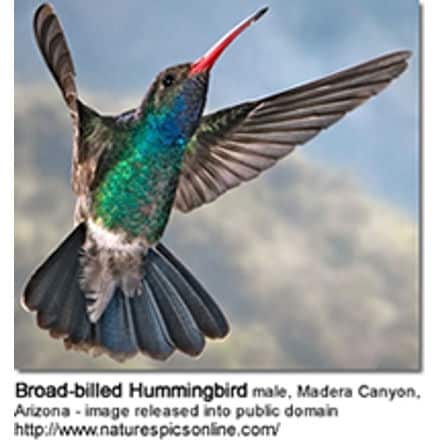
White-eared Hummingbirds (Basilinna leucotis) – Accidental / Vagrants– Occurred as a vagrant eastward to Mississippi and Michigan. Could conceivably reach Massachusetts as well.
ID: Both the male and female White-eared Hummingbird have a prominent white ear stripe (more boldly colored in the male) for which this species was named.
The upper plumage and chest is mostly green and the undertail feathers whitish. The long, thin, straight bill is red at the base.
The male has a turquoise throat, turquoise and white spotted chest and flanks, a deep green back, a white belly and breast and a wide violet-blue band on a short, thin red and black bill.
The female has a white or cream colored throat that is speckled with green, a whitish belly, deep green crown and a drab green back.
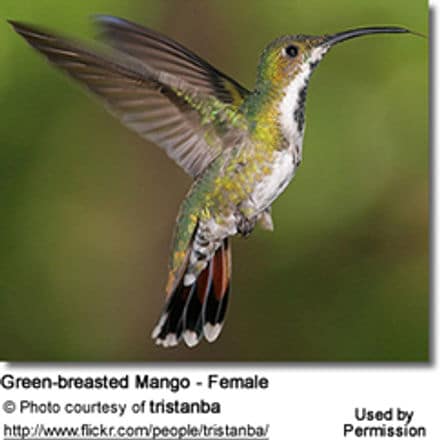
Adult Males: Overall glossy bright green plumage; more yellowish brown on the flanks (sides) and vent. Irridescent blue gorget (throat patch) that extends from the throat to below the chest – which may appear black in poor light conditions. Outer tail feathers range in color from deep purple tipped with black ot orangey-red to magenta.
Females and Juvenile Males have a broad band of magenta and dark blue on the outer tail feathers, with narrow white tips on the outer 3 to 4 tail feathers. The back is bronze-green. Below they are white with a dark central stripe that is black on the chin and changes to blue-green on the throat.

Some hummingbird species have been reported, but have not been adequately documented to be accepted by the State Records Committee:
Antillean Crested Hummingbird,Orthorhyncus cristatus – vagrant / accidental
Cuban Emerald, Chlorostilbon ricordii– (Although there were confirmed sightings in southern Florida, (One of which was confirmed by Dr. John T. Zimmer, Curator of Birds at the American Museum of Natural History in New York City.) – Rare Vagrant
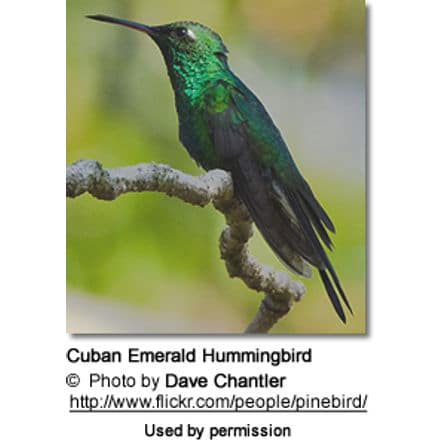
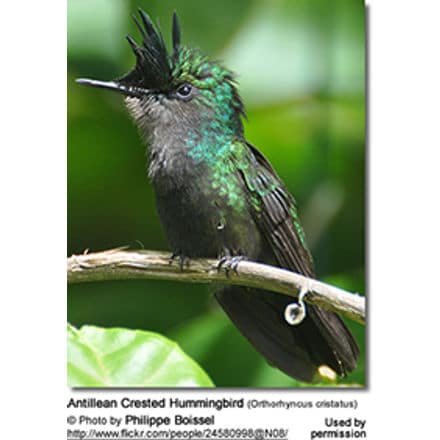
Additional hummingbird species that might (or may already have) expand their territory into Florida are:
Green Violetear Hummingbirds (Colibri thalassinus) – Alabama, Georgia, North Carolina –
They are mostly resident in Mexico and Central America, but some seasonal movements have been observed. They may wander north to the United States and even as far north as Canada.
Blue-throated Hummingbirds (Lampornis clemenciae) – Found in adjacent Georgia as well as Louisiana, South Carolina
The upper plumage is dull green, fading to a medium grey on the underside. It has white stripes behind the eyes and a narrower stripe extending backward from the corner of its relatively short bill, next to a blackish cheek patch.
The male can be identified by the iridescent blue throat patch (gorget), which may appear black or grey color in poor light.
The female and young have grey throats.

Magnificent or Refulgent Hummingbirds (Eugenes fulgens) – Found in adjacent Alabama, Georgia
They are nearly twice as large as any other hummingbird species found in this State, and can often be identified by their size alone.
The male has a metallic green throat and a black chest. His forehead and crown are purple and the back is dark green.
The female plumage is less bright. Her chest is solid grey. Her back and crown are olive green. Her tail feathers are pearl-grey tipped.
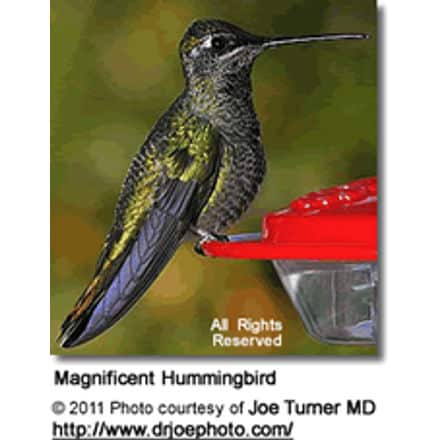
Costa’s Hummingbirds (Calypte costae) – Found in adjacent Alabama
Males can easily be identified by the glossy purple crown and long, conspicuous throat feathers that project markedly down the side of the throats, giving it an elongated “moustache” appearance. The back is metallic green.
Females have greyish-green crowns (fop of the head) and backs. The chin and the plumage below are whitish, except for some black spotting on her throat. Her flanks are buffy-colored. She has a dark tail with white tips on the outer tail feathers.
They resemble the Anna’s Hummingbirds, but the male’s gorget (throat feathers) is longer than that of the Anna’s.


